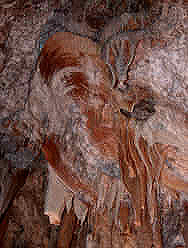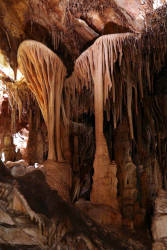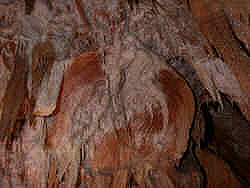Shield




Shields or Discs are rather rare, only few caves have one, very few have more than one. In very few caves they are abundant, like in Lehman Cave, U.S.A., where more than 500 can be found.
Shields look like huge discs, although they are generally an incomplete circle. At their back end they are attached to the cave wall. They stick out of the wall upwards, at an angle between 10° and 60°; common is about 30°. Almost circular, sometimes elliptical, plates of about two centimetres thick and a diameter of up to one meter are found. They have concentric rings similar to the layers of other dripstones. Some have flowstone growing downwards from the shield to the floor, similar to common waterfall-like flowstones. But there are never flowstones on top of the shield.
Sometimes a shield collapses, when the weight of the stalactites growing downwards overstrains the stability of the plate. Such a collapse, or a close look at the disc’s rim, reveals a characteristic of shields. They always consist of two parallel plates, each 1 cm thick, separated by a medial crack.
It forms by water seeping through this medial crack powered by capillary forces. The shield is formed by an almost horizontal fissure in the rock, where water emerges. Water standing in the fissure fills it to the surface of the rock, probably forming a dam of water, held together by the surface tension. Carbon dioxide is released into the cave air, as a result the dissolved limestone in the water is slowly precipitating, forming calcite criystals floating on the surface of the water dam. First, two parallel dams form along the crack in the cave wall as the floating calcite crystals adhere to the rock around the crack and form dams. Then the precipitated calcite adheres to the dams on the top and bottom, the two dams so that they grow.
Later, when the dams become higher and higher, they start to become circles, as the water flows from the source to the full lenth of the rim. It flows for a certain distance until it reaches the rim, and where it reaches first, the growth rate is highest. As a result, the shield always becomes circular, with the rim always the same distance from the water source.
A general necessity of the formation of Shields is an extremely slow but almost constant flow of water. If the amount of water is a little higher, the water flows out of the rim of the shield and growth of limestone beneath the shield starts. Thus, typical flowstones are formed below the Shield.
Literature
- Morgan Hill, Gretchen M. Baker (2021): Counting Cave Shields: A Lehman Caves Study, Poster. pdf
- Examples
 Grand Caverns, VA, U.S.A.
Grand Caverns, VA, U.S.A. Lehman Caves, NV, U.S.A.
Lehman Caves, NV, U.S.A. Grotte de la Madeleine, Ardeche, France
Grotte de la Madeleine, Ardeche, France Aven d’Orgnac, Ardeche, France
Aven d’Orgnac, Ardeche, France Punkevní jeskyně, Czech Republic
Punkevní jeskyně, Czech Republic
 Search DuckDuckGo for "Shield speleothem"
Search DuckDuckGo for "Shield speleothem" Cave Shields: The Wonder of Lehman Caves (visited: 10-AUG-2023)
Cave Shields: The Wonder of Lehman Caves (visited: 10-AUG-2023)
 Index
Index Topics
Topics Hierarchical
Hierarchical Countries
Countries Maps
Maps